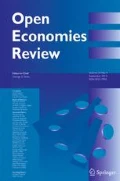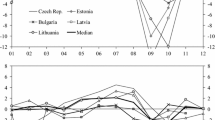Abstract
The stability of the labour share of income is a fundamental feature of many macroeconomic models. Empirically however, the labour share varies considerably across countries and across sectors within countries. In addition, gradual declines in the labour share have been documented in many countries leading to much debate on the causes of the reduction. This paper examines several of the potential drivers of variation in the labour share across countries and sectors in Europe. Beginning with a simple shift-share analysis, we demonstrate that observed changes has been primarily driven by changes within rather than between sectors. We then use aggregated microdata to investigate the strength of correlation between sectoral distributions of labour shares and measures of productivity and market power. Our main findings are that the advance of globalisation and a widening productivity gap from the rise of “superstar firms” are negatively related to the labour share, and that this negative relationship is stronger for the reallocation margin within sectors compared to its link to between sector reallocation.




Similar content being viewed by others
Availability of Data and Material
Available on application to CompNet project.
Code Availability
Stata software, code available on request.
Notes
It occurred in seven of the eight largest economies of the world, in emerging markets such as China, India and Mexico that have opened up to international trade, and even in Scandinavian countries where levels of labour unionisation has traditionally been strong (Karabarbounis and Neiman 2014).
See Anderton et al. (2017) for the factors that can explain wage rigidities in both an upturn and downturn.
By using micro-aggregated data focusing on firms and their employees, this removes the confounding effects of self-employment on labour share estimates (Adrjan 2018).
Andrews et al. (2016) were among the first to identify the diverging productivity trends between ‘frontier’ and ‘laggard’ firms globally.
Falvey et al. (2011) develop a heterogeneous firm model to illustrate how productivity gaps are impacted by participation in global value chains.
The reader must be aware that data collection rules and procedures across countries are different, and out of CompNet’s control. Hence, despite all efforts made to improve sample comparability across countries (including the use of population weights), some country samples might still suffer from biases. For a more detailed account of raw data characteristics and sample biases, please refer to the Cross-Country Comparability Report (CompNet 2018b).
Lopez-Garcia et al. (2014) checked correlations of sector-year turnover and labour from CompNet for a number of countries with official statistics from Eurostat as part of a data validation exercise, obtaining correlations between 0.7 and 0.9. Gutierrez and Piton (2020) contrast KLEMS and CompNet based labour share estimates for manufacturing industries, showing that they behave remarkably similar.
Although not the focus of this paper, this may allude to a high cost of reallocation with important implications for productivity growth.
See Appendix 1 for more detail on the Irish labour share and 2015 distortions.
The relationship is estimated via OLS to enable this decomposition. However, given that the labour share is a persistent variable, this may lead to bias in the estimated coefficients. Although not verified in this paper, OLS—ignoring this persistence – will be valid as long as the estimated relation is a long-run vector.
See Berlingieri et al. (2017) for further evidence widening gaps of these being present across a number of countries using firm-level data.
See Kılınç (2018) for the issues relating productivity measurement and the need to control for mark-ups.
Broadly similar results can be obtained by using the standard deviation as the measure of dispersion.
Falvey et al. (2011) develop a heterogeneous firm model to illustrate how productivity gaps are impacted by participation in global value chains.
References
Adrjan P (2018) The mightier, the stingier: Firms’ market power, capital intensity, and the labor share of income. MPRA Paper 83925
Anderton R, Hantzsche A, Savsek S, Tóth M (2017) Sectoral wage rigidities and labour and product market institutions in the Euro Area. Open Econ Rev 28(5):923–965
Andrews D, Criscuolo C, Gal P (2016) The Best versus the Rest: The Global Productivity Slowdown, Divergence across Firms and the Role of Public Policy. OECD Product Work Papers 5. OECD Publishing, Paris. https://doi.org/10.1787/63629cc9-en.
Autor D, Dorn D, Katz LF, Patterson C, Van Reenen J (2020) The fall of the labor share and the rise of superstar firms. Quarterly J Econ 135(2):645–709
Bental B, Demougin D (2010) Declining labor shares and bargaining power: An institutional explanation. J Macroecon 32(1):443–456
Bentolila S, Saint-Paul G (2003) Explaining movements in the labor share. Contrib Macroecon 3(1)
Berlingieri G, Blanchenay P, Calligaris S, Criscuolo C (2017) Firm-level Productivity Differences: Insights from the OECD’s MultiProd Project International Productivity Monitor. Centre for the Study of Living Standards 32:97–115, Spring
Blanchard O, Giavazzi F (2003) Macroeconomic effects of regulation and deregulation in goods and labor markets. Q J Econ 118(3):879–907
Brown JN, Ashenfelter O (1986) Testing the Efficiency of Employment Contracts. J Political Econ 94(3), Part 2
CompNet (2018a) User Guide for the 6th Vintage of the CompNet Dataset. Available at: https://www.comp-net.org/fileadmin/_compnet/user_upload/Documents/User_Guide_6th_Vintage.pdf.
CompNet (2018) Assessing the reliability of the CompNet micro-aggregated dataset for policy analysis and research; Coverage, representativeness and cross-EU comparability. Available at: https://www.comp-net.org/fileadmin/_compnet/user_upload/Documents/Cross-Country_Comparability_Report.pdf.
CompNet (2018c) CompNet’s 6th vintage of data: Novelties and main stylised facts. Available at: https://www.comp-net.org/fileadmin/_compnet/user_upload/Documents/Cross-country_report_updated_21.12.18.pdf
Dao MC, Das MM, Koczan Z, Lian W (2017) Why is labor receiving a smaller share of global income? Theory and empirical evidence. Int Monet Fund Work Paper WP/17/169
De Loecker J, Eeckhout J (2018) Global market power. Natl Bureau Econ Res Work Paper 24768
De Loecker J, Warzynski F (2012) Markups and firm-level export status. Am Econ Rev 102(6):2437–2471
Department of Finance (2018) "GDP and 'Modified GNI' – Explanatory Note". https://assets.gov.ie/4910/181218123252-71a2c297f26b419fa3696d7349e3e788.pdf
Elsby MW, Hobijn B, Şahin A (2013) The decline of the US labor share. Brook Pap Econ Act 2013(2):1–63
Eurostat (2016) High-tech industry and knowledge-intensive services metadata available at https://ec.europa.eu/eurostat/cache/metadata/en/htec_esms.htm (accessed 29/11/2019)
Falvey R, Greenaway D, Yu Z (2011) Catching up or pulling away: Intra-industry trade, productivity gaps and heterogeneous firms. Open Econ Rev 22(1):17–38
Gollin D (2002) Getting income shares right. J Polit Econ 110(2):458–474
Gutiérrez G, Piton S (2020) Revisiting the global decline of the (non-housing) labor share. American Economic Review: Insights 2(3):321–338
Hall RE (1988) The relation between price and marginal cost in US industry. J Polit Econ 96(5):921–947
Kaldor N (1961) Capital accumulation and economic growth. In The theory of capital. Palgrave Macmillan, London 177–222
Karabarbounis L, Neiman B (2014) Capital depreciation and labor shares around the world: measurement and implications. Natl Bureau Econ Res Work Paper 20606
Kılınç U (2018) Assessing productivity gains from international trade in a small open economy. Open Econ Rev 29(5):953–980
Klein MC, Pettis M (2020) Trade Wars are Class Wars: How Rising Inequality Distorts the Global Economy and Threatens International Peace. Yale University Press, New Haven and London
Lawless M, Whelan KT (2011) Understanding the dynamics of labor shares and inflation. J Macroeconom 33(2):121–136
Lopez-Garcia P, Di Mauro F, Benatti N, Angeloni C, Altomonte C, Bugamelli M, D'Aurizio L, Navaretti GB, Forlani E, Rossetti S, Zurlo D (2014) Micro-based evidence of EU competitiveness: the CompNet database. NBB Work Paper 253
Magalhães M, Sequeira T, Afonso Ó (2019) Industry Concentration and Wage Inequality: a Directed Technical Change Approach. Open Econ Rev 30:457–481
Mertens M (2019) Micro-mechanisms behind declining labour shares: Market power, production processes, and global competition. IWH-CompNet Discuss Papers No. 3/2019
Schwellnus C, Kappeler A, Pionnier P (2017) The decoupling of median wages from productivity in OECD countries. Int Product Monitor 32:44–60
Solow RM (1956) A contribution to the theory of economic growth. Q J Econ 70(1):65–94
Stiglitz JE (2012) The price of inequality: How today's divided society endangers our future. WW Norton & Company
Wolff EN (2010) Recent wealth trends in the household wealth in the United States: Rising debt and the middle-class squeeze: an update to 2007. Levy Economics Institute of Bard College, Work Paper 589
Funding
Funding is provided to the ESRI as part of a joint research programme between the ESRI, Department of Finance (Ireland) and the Office of the Revenue Commissioners (Ireland) on the Macro-economy, Taxation and Banking.
Author information
Authors and Affiliations
Corresponding author
Ethics declarations
Conflicts of Interest
None.
Additional information
Publisher's Note
Springer Nature remains neutral with regard to jurisdictional claims in published maps and institutional affiliations.
Appendix 1. Irish Labour Share and GDP Measurement Issues
Appendix 1. Irish Labour Share and GDP Measurement Issues
According to standard aggregates, the share of national income going to wages in Ireland has fallen consistently in recent decades and European Commission data show that the wage bill expressed as a fraction of GDP in Ireland is the lowest in the European Union.
However, the decline in the labour income share of value added is clearly overstated by the significant growth of the multinational sector since the 1980’s and, more recently, by distortions arising in parts of the multinational sector which artificially inflate (non-labour) activity in Ireland, most notably with the exceptional growth rate recorded in 2015.
Department of Finance (2018) showed that using modified GNI as the numerator, which excludes much of the statistical distortions arising from globalisation, enables a more meaningful analysis of trends in the labour income share over time. Figure 5 below shows the labour share of time with GDP, GNI and GNI* as the numerators. All demonstrate a negative trend over time, in line with the global decline. The GNI* measure has a much higher level however, and does not display the level shift in 2015. In fact, the GNI* based labour share is much more in line with the EU average, as illustrated in Fig. 6.
Rights and permissions
About this article
Cite this article
Lawless, M., Rehill, L. Market Power, Productivity and Sectoral Labour Shares in Europe. Open Econ Rev 33, 453–476 (2022). https://doi.org/10.1007/s11079-021-09653-3
Accepted:
Published:
Issue Date:
DOI: https://doi.org/10.1007/s11079-021-09653-3







